As America’s socially turbulent 1960s drew to a close and newly-elected president Richard Nixon was codifying his anti-drug agenda into law, a handful of pro-pot activists arose to challenge those efforts. These reformers found an unlikely and invaluable ally in a conservative, middle-aged associate professor from Harvard by the name of Lester Grinspoon, MD.
Born and raised in nearby Newton, Massachusetts, Grinspoon worked his way into Harvard Medical School, where he received his doctorate in Psychiatry in 1955 and later accepted a teaching position. His academic career remained rather unremarkable until a decade later when he met young astronomer Carl Sagan (later of Cosmos fame) at a faculty dinner. The two intellectual giants immediately bonded over their mutual opposition to the Vietnam War, and a lifelong friendship was sparked.
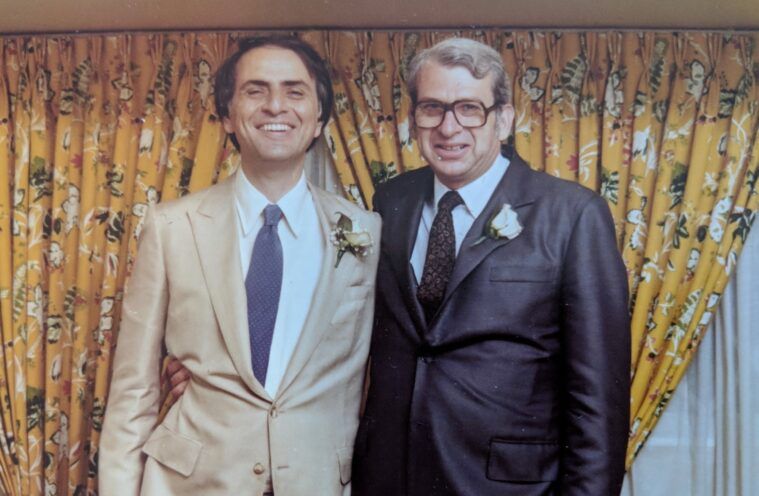
But before long, Grinspoon realized that Sagan and others in their intellectual circle enjoyed smoking marijuana and even suggested that he try it. Both intrigued by his friend’s affinity for the drug and concerned by what he believed was a dangerous habit, Grinspoon did what any scientist worth their salt might do—he started researching it.
MARIHUANA RECONSIDERED
When he began his study of marijuana in 1967, Grinspoon’s initial intention was to “define scientifically the nature and degree of those dangers” and persuade Sagan to stop using it. Instead, the evidence led him to the opposite conclusion—that “there was little empirical evidence to support my beliefs about the dangers of marijuana,” that it was “remarkably non-toxic,” and that it may actually have some beneficial medicinal applications. Grinspoon published his initial findings in the December 1969 edition of Scientific American, in an article called simply “Marihuana.” [1]

“Based on the reaction to that [article], he was encouraged to do a book-length exposition of what he had learned,” Grinspoon’s son David recalls, “which was basically that he had been brainwashed along with everybody else into thinking that marijuana was this dangerous substance.”
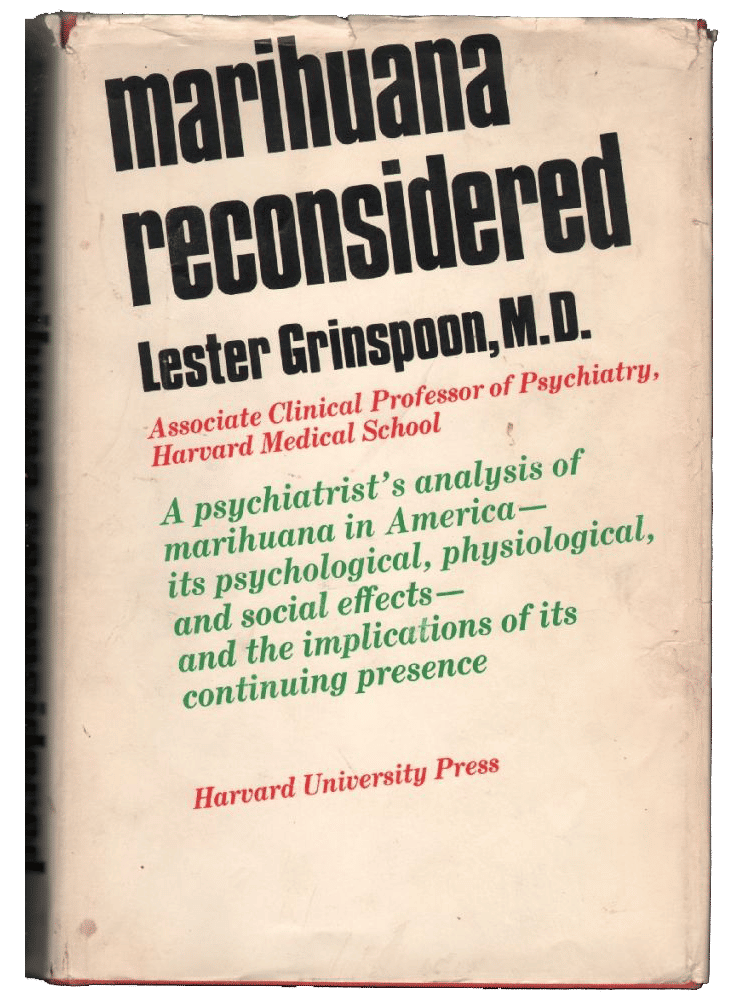
Two years later, he published the book Marihuana Reconsidered (Harvard University Press), in which he dispels many of the myths surrounding the much-maligned herb.
“I have concluded,” Grinspoon writes, “that marijuana is a relatively safe intoxicant which is not addicting, does not in and of itself lead to the use of harder drugs, is not criminogenic, and does not lead to sexual excess.” He also noted that the only real harm associated with cannabis was, in his opinion, “the way we as a society were dealing with people who use it.”
The book also features a passionate essay extolling the plant’s virtues by an anonymous cannabis user dubbed “Mr. X,” whose identity remained a family secret for over 30 years. Mr. X, it turned out, had been Sagan all along—a fact that Grinspoon only revealed a few years after Sagan’s death in 1996.
Marihuana Reconsidered’s impact was immense and immediate: disdained and disowned by his Harvard peers, but extolled by the fledgling legalization community, for whom it was a valuable resource and a validation of their mission.
“Lester, without question, was the intellectual leader of the entire movement from the moment his book was published in 1971,” asserts NORML founder Keith Stroup. “Lester Grinspoon’s book was the Bible.”
NEMESIS OF NIXON
The book even made it onto the president’s radar: after reading an excerpt from the New York Times review of Marihuana Reconsidered in his daily news brief, Nixon launched into an anti-Semitic tirade to his chief of staff Bob Haldeman: “Every one of the bastards that are out for the legalization of marijuana is Jewish!,” he can be heard saying in his infamous oval office audiotapes. “What the Christ is the matter with the Jews, Bob? I suppose it’s because most of them are psychiatrists.”
Nixon then circled Grinspoon’s name and scribbled a note in the margin below that read: “This clown is far on the left.”
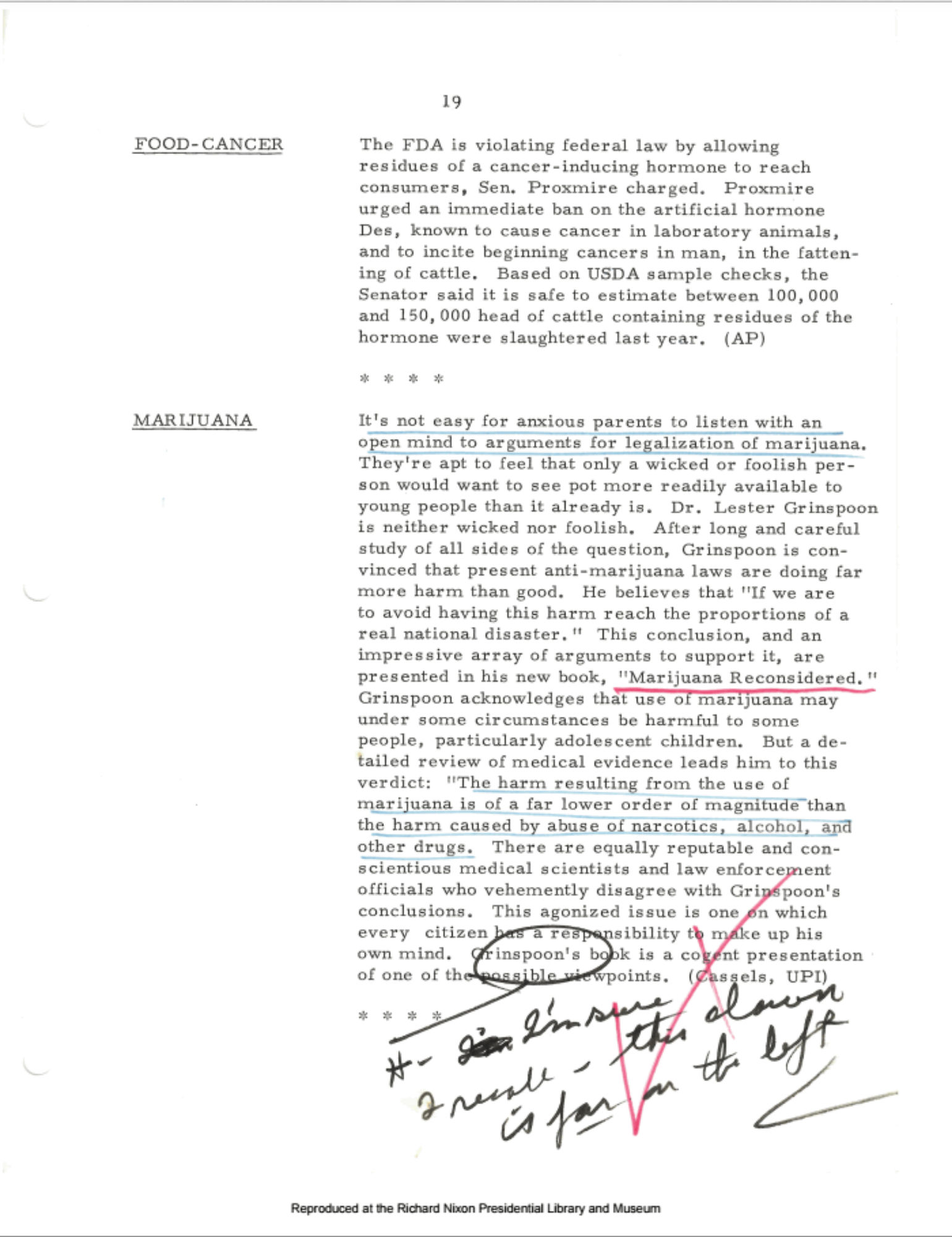
“He knew that he was kind of on Nixon’s enemies list, but he hadn’t seen that note specifically until this reporter from the Boston Globe got a copy of that,” says David. (Remarkably, that direct link between Nixon’s comments and the release of Dr. Grinspoon’s book was not officially verified until that reporter Dan Adams requested the documents from the Nixon Presidential Library in 2018. Adams got the tip from Lester’s friend, former High Times associate publisher Rick Cusick.)“When Lester saw that, he was just delighted. He said, ‘Wow—I made it onto the enemies list of one of history’s biggest assholes!’”
THE SHAFER COMMISSION
Dr. Grinspoon would continue to be a thorn in Nixon’s side. The same year that Marihuana Reconsidered was published, he was one of only two pro-pot witnesses called to testify before the National Commission on Marihuana and Drug Abuse in Washington D.C.—better known as the Shafer Commission. Nixon had appointed the commission to investigate the potential harm of cannabis as a means to bolster his argument for categorizing it as a Schedule 1 drug under his newly-passed Controlled Substances Act. Stroup, who first met and befriended Grinspoon at these hearings, recalls being immediately impressed by his confidence. “He was so self-assured, so comfortable with his own intellect, that he showed no signs of being intimidated. He was the most powerful person testifying at those hearings.”
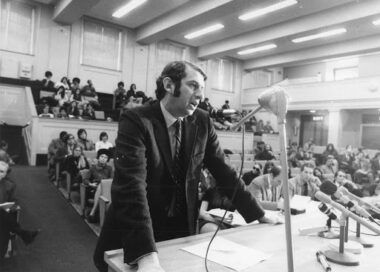
Not only did Grinspoon testify to marijuana’s benign nature, but he also called into question the objectivity of the commission itself. His testimony proved highly effective: when the commission released their final report in 1972 (entitled “Marihuana, a Signal of Misunderstanding”), it concluded that cannabis was in fact not a danger to society, and even recommended decriminalizing it (a recommendation which Nixon ignored, naturally).
JOHN LENNON

Later that year, Grinspoon was again called to testify before Congress on another high-profile case—this time, at the deportation hearings for former Beatle John Lennon. This once again pitted Lester against the president’s personal agenda: when Lennon had made public statements against the president during his reelection campaign, Nixon tried to use a past misdemeanor cannabis possession charge against Lennon as a basis to kick him out of the country. (In 1968, the London police had found a small amount of “cannabis resin” in Lennon’s London home.) Lennon’s lawyer Leon Wildes called in Dr. Grinspoon as his first outside witness to clarify a critical technicality:
“Dr. Grinspoon, is cannabis resin marijuana?” Wildes asked.
“No, cannabis resin is not marijuana,” Grinspoon replied.
“Is cannabis resin a narcotic drug?”
“No, cannabis resin is not a narcotic drug.”
With the aid of Grinspoon’s testimony, Wiles argued that resin/hashish was a secretion of the cannabis plant, but not technically marijuana, and therefore the immigration law citing “narcotics and marijuana” didn’t legally apply. Eventually, Wildes’ strategy succeeded: though Lennon’s deportation hearings continued until after Nixon’s resignation in 1974, Grinspoon’s testimony—along with the hundreds of character witnesses and letters submitted on Lennon’s behalf—led to Lennon finally getting his green card in October 1975.

To show their gratitude, John and Yoko took Grinspoon out to dinner, sent him flowers, and gifted him with albums autographed to his sons Danny and David. (Interesting side note: it was one of Lennon’s albums—The Beatles’ masterpiece Sgt. Pepper’s Lonely Hearts Club Band—that Dr. Grinspoon was “astounded” by when listening to after getting high with Sagan for the first time, some two years after Marihuana Reconsidered had been published.)
FAMILY TRAGEDY

Unfortunately, Dr. Grinspoon had an opportunity to witness cannabis’ medicinal efficacy first-hand when he and his wife Betsy began administering it to their teenage son Danny to help him cope with the side effects of chemotherapy. Danny had been diagnosed with acute lymphocytic leukemia in 1967 at the age of ten and had been suffering from terrible nausea and vomiting after his treatments…but after he started smoking a few hits from a joint before each session, those symptoms disappeared—dramatically increasing his quality of life and the family’s morale. Sadly, Danny lost his battle with leukemia in 1973, but his medicinal marijuana use led to the first scientific study of cannabis for nausea in 1975.
THE MEDICAL MARIJUANA MOVEMENT
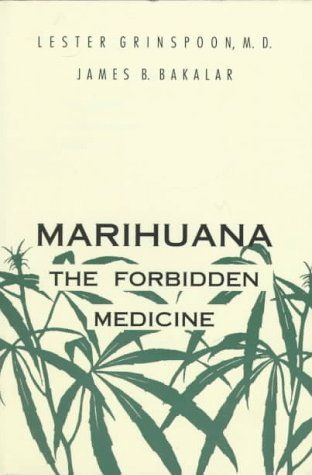
Throughout the 1970s and 80s, Grinspoon authored many other books about illicit drugs, including Psychedelic Drugs Reconsidered, Psychedelic Reflections, and Cocaine: A Drug and it’s Social Evolution, among others. Then in 1993, he co-authored a second book about cannabis called Marihuana: The Forbidden Medicine (with Harvard Law professor James Bakalar)—a compendium of anecdotal evidence that further explored the medical potential of the plant and helped bolster California’s burgeoning medical marijuana movement. World of Cannabis advisory board member Valerie Leveroni Corral, who co-founded the Wo/Men’s Alliance for Medical Marijuana (the first medical cannabis collective recognized by the U.S. government), attests to the book’s influence.

“It absolutely had an impact on our movement,” Corral attests. “It had a scholarly element that was profoundly important to not look like just a ragtag team of activists, and that’s really when I began to form a relationship with [Lester] as a friend, confidant, and mentor.”
Just a few years after its publication, Corral would join fellow California advocates Dennis Peron, “Brownie Mary” Rathbun and others in co-authoring and campaigning for the Compassionate Use Act—better known as Proposition 215—the voter initiative that, after passing in 1996, legalized marijuana for medical purposes in America for the first time.
“Without a doubt, the seriousness of [Grinspoon’s] writing lent to the incredible activism that was going on largely in the San Francisco area,” affirms former NORML executive director Allen St. Pierre. “You had Lester on the East Coast lending all of this intellectual gravitas with his book, and you had the activists out [on the West Coast] pushing the envelope…we have legal marijuana in many parts of the country today because of these two unique forces working together.”
THE NEW NORML
It was also shortly after Forbidden Medicine’s publication that Grinspoon was tapped by NORML to overhaul its struggling organization.
“In 1994, the NORML board, for all intents and purposes, imploded and couldn’t get over a number of fundamental problems at the time,” St. Pierre explains. “So rather than have a protracted board fight, Lester was contacted and was willing to put forward his good name and reputation to try to pull together an entirely new board…and everybody was immediately deferential to such.”
Stroup had enlisted Grinspoon into the ranks of NORML’s leadership within the first few years of meeting him—first onto their advisory board, then onto their board of directors. Now, on the brink of collapse, the organization turned to him to save them.

“The only thing the board could agree on is that they trusted Lester’s judgment, and they knew whoever he picked would be good for NORML and for the movement,” says Stroup.
At Grinspoon’s recommendation, Stroup (who had effectively left the organization some 15 years prior due to his role in a scandal involving the Carter Administration) was reinstated as NORML’s executive director, and a new board of directors was compiled—ushering in a new “golden age” for the organization. Grinspoon continued to serve on NORML’s board for decades and was a featured speaker at many of their conventions and conferences. He also made regular appearances at their booth at the Boston Freedom Rally each September. It was there, at the Rally booth that NORML always shared with High Times, that I first met and smoked with the good doctor nearly two decades ago—a tradition I looked forward to each year thereafter. It was also at the Rally in 2007 that our friends Stroup and Cusick were arrested for smoking a joint together behind that booth. And when they decided to take their case to trial in hopes of a jury nullification verdict, it was Lester who kickstarted their defense fund with a $5000 contribution, submitted a 50-odd page affidavit on their behalf, and helped convince renowned Harvard Law Professor Charles “Billion-Dollar Charlie” Nesson to take their case pro bono.
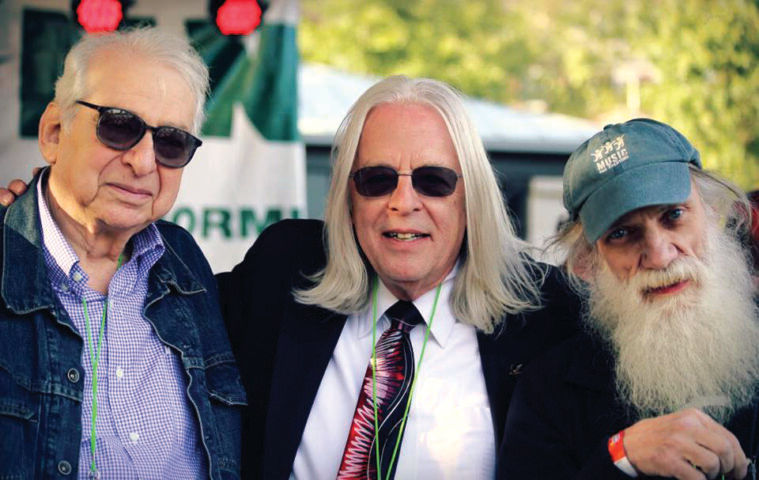
HONORS & ACCOLADES
Grinspoon retired from teaching as an associate professor emeritus in 2000, having twice been “green listed” (denied full professorship) by the Harvard promotion committee, whose conservative members did not approve of how his controversial stance on cannabis reflected upon the school’s reputation.
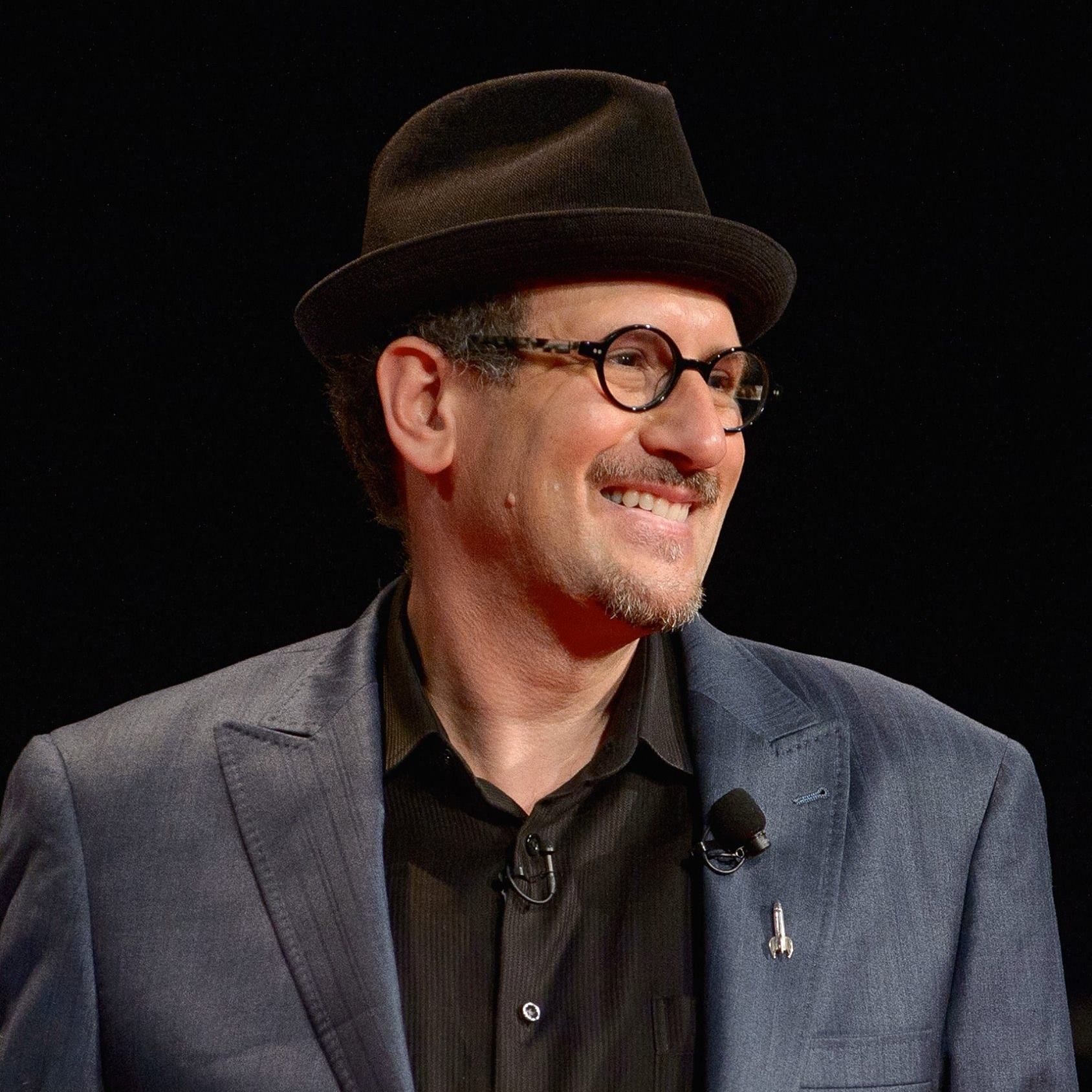
“He did not get a full professorship, which is objectively silly given his level of accomplishments,” his son David notes. “He thrived in the academy at Harvard, but they didn’t always give him the recognition he deserved, or sometimes he got shit for being out on the leading edge that he was on. There was a time when that bothered him, but it ceased to bother him because he got so much out of the community of activists and writers and scholars that shared his passions and were engaged in this movement with him.”
Indeed, Dr. Grinspoon was a revered and beloved figure in the cannabis community, and was honored numerous times over the years: In 1990, he received the Alfred R. Lindesmith Award for Achievement in the Field of Scholarship and Writing from the Drug Policy Foundation in Washington, D.C. In 1999, the NORML board of directors established the Lester Grinspoon Award for Outstanding Achievement in the Field of Marijuana Law Reform, naming him as its first recipient. High Times named an award after him as well: their Lester Grinspoon Award for Lifetime Achievement. There’s a band in Australia who named themselves “Grinspoon” in his honor, and there’s even a cannabis strain named after him—“Dr. Grinspoon,” a potent heirloom sativa released in 2009 by Barney’s Farm in Amsterdam.
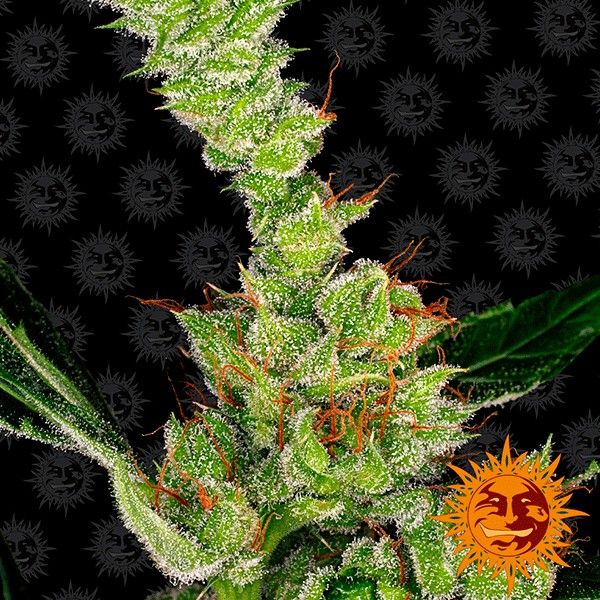
In 2012, Grinspoon received the Cannabis Culture award from the Hash, Marihuana and Hemp Museum. And most recently, on April 20 of this year, World of Cannabis, in collaboration with the Cannabis Business Awards, named him one of our 420 Icons—that is, one of the top 100 cannabis influencers of all time.
DEATH & LEGACY
After spending half a century fighting cannabis prohibition and misinformation, Dr. Grinspoon spent the last decade of his life fighting cancer. On the morning of June 25—one day after celebrating his 92nd birthday—he passed away peacefully at his home in the suburbs of Boston. Thanks to his groundbreaking body of work and courageous activism, Lester Grinspoon will be forever remembered as one of the most consequential figures in cannabis history.
Watch Cannthropology’s exclusive memorial to Dr. Grinspoon featuring all of those quoted in this article by clicking here and becoming a WOC member, or listen to it on Episode 5 of Cannthropology wherever you get your podcasts. You can also watch interviews with Dr. Grinspoon and other videos about him in the World of Cannabis Grinspoon playlist on YouTube.
COLLECTION ITEMS:
- “Marihuana” article by Lester Grinspoon; Scientific American, December 1969; Item #M061
(This content was previously published on worldofcannabis.museum/cannthropology and is reprinted with permission.)










